A Survey of Latest Wi-Fi Assisted Indoor Positioning on Different Principles
Abstract
:1. Introduction
- Basic description and analysis of indoor positioning. This paper describes the indoor positioning problem and its applications. We state the key issues in anti-interference and practical deployment. We also outline mainstream alternative methods and compare their advantages and disadvantages.
- Classification and review of related work. According to the positioning principle, we divide Wi-Fi-assisted indoor positioning schemes into three categories. We state the principles of these categories and point out their merits and demerits. We also review representative work of corresponding simple and hybrid schemes.
- Prospects. We point out the open challenges of Wi-Fi-assisted indoor positioning, the multi-path effect, device deployment optimization, and data privacy. To these ends, we prospect promising directions in future work.
2. Scenarios and General Advances
2.1. Application Scenarios
2.2. Key Issues
2.2.1. Anti-Interference
2.2.2. Practical Deployment
2.3. Alternative Methods
2.3.1. Non-Wi-Fi
2.3.2. Wi-Fi
3. Wi-Fi-Assisted Schemes on Different Principles
3.1. AoA
3.1.1. Principle
3.1.2. Single-AP Schemes
3.1.3. Multi-AP Schemes
3.2. RSSI
3.2.1. Principle
3.2.2. Fingerprint-Based Schemes
3.2.3. Fingerprint Database Constructing and Updating
3.2.4. Fingerprint Matching Algorithms
3.2.5. Model-Based Schemes
3.3. Time
3.3.1. Principle
3.3.2. Traditional Schemes
3.3.3. FTM-Based Schemes
3.4. Hybrid Schemes
3.4.1. Passive Schemes
3.4.2. Active Schemes
3.4.3. Special Schemes
4. Open Challenges and Promising Directions
4.1. Multi-Path Effect
4.2. Device Deployment Optimization
4.3. Data Privacy
5. Conclusions
Author Contributions
Funding
Institutional Review Board Statement
Informed Consent Statement
Data Availability Statement
Conflicts of Interest
References
- Enge, P.; Misra, P. Special Issue on Global Positioning System. Proc. IEEE Inst. Electr. Electron. Eng. 1999, 87, 3–15. [Google Scholar] [CrossRef]
- Fathi Alshweihdi, A.; Abduljalil Alamrouni, E.; Mohamed Elkawafi, S.; Mohammed Osama Elzwaie, A.; Abdulnabi Shamata, H.; Najem Alfergani, A.; Younis, A. Location Prediction in Mobile Cellular Networks: Machine Learning Approach. In Proceedings of the 7th International Conference on Engineering & MIS 2021 (ICEMIS’21), Almaty, Kazakhstan, 11–13 October 2021; pp. 1–5. [Google Scholar]
- Chen, Z.; Zhu, G.; Wang, S.; Xu, Y.; Xiong, J.; Zhao, J.; Luo, J.; Wang, X. M3M3: Multipath Assisted Wi-Fi Localization with a Single Access Point. IEEE Trans. Mob. Comput. 2019, 20, 588–602. [Google Scholar]
- Xiong, J.; Jamieson, K. ArrayTrack: A Fine-Grained Indoor Location System. In Proceedings of the 10th USENIX Symposium on Networked Systems Design and Implementation (NSDI’13), Lombard, IL, USA, 2–5 April 2013; pp. 71–84. [Google Scholar]
- Klepeis, N.E.; Nelson, W.C.; Ott, W.R.; Robinson, J.P.; Tsang, A.M.; Switzer, P.; Behar, J.V.; Hern, S.C.; Engelmann, W.H. The National Human Activity Pattern Survey (NHAPS): A resource for assessing exposure to environmental pollutants. J. Exp. Sci. Environ. Epidemiol. 2001, 11, 231–252. [Google Scholar] [CrossRef] [PubMed]
- IEEE Std 802.11-2016 (Revision of IEEE Std 802.11-2012); IEEE Standard for Information Technology—Telecommunications and Information Exchange between Systems Local and Metropolitan Area Networks—Specific Requirements—Part 11: Wireless LAN Medium Access Control (MAC) and Physical Layer (PHY) Specifications. IEEE Standards Association: Piscataway, NJ, USA, 2016; pp. 1–3534.
- Liu, F.; Liu, J.; Yin, Y.; Wang, W.; Hu, D.; Chen, P.; Niu, Q. Survey on WiFi-Based Indoor Positioning Technologies. IET Commun. 2020, 14, 1372–1383. [Google Scholar] [CrossRef]
- Rai, A.; Chintalapudi, K.K.; Padmanabhan, V.N.; Sen, R. Zee: Zero-effort crowdsourcing for indoor localization. In Proceedings of the 18th Annual International Conference on Mobile Computing and Networking (MobiCom’12), Istanbul, Turkey, 22–26 August 2012; pp. 293–304. [Google Scholar]
- Ma, C.; Wu, B.; Poslad, S.; Selviah, D.R. Wi-Fi RTT ranging performance characterization and positioning system design. IEEE Trans. Mob. Comput. 2020, 21, 740–756. [Google Scholar] [CrossRef]
- Xiong, J.; Sundaresan, K.; Jamieson, K. Tonetrack: Leveraging frequency-agile radios for time-based indoor wireless localization. In Proceedings of the 21st Annual International Conference on Mobile Computing and Networking (MobiCom’15), Paris, France, 7–11 September 2015; pp. 537–549. [Google Scholar]
- Bahl, P.; Padmanabhan, V.N. RADAR: An in-building RF-based user location and tracking system. In Proceedings of the Conference on Computer Communications, Nineteenth Annual Joint Conference of the IEEE Computer and Communications Societies (IEEE INFOCOM 2000), Tel Aviv, Israel, 26–30 March 2000; Volume 2, pp. 775–784. [Google Scholar]
- Zhao, P.; Liu, W.; Zhang, G.; Li, Z.; Wang, L. Preserving Privacy in WiFi Localization With Plausible Dummy Locations. IEEE Trans. Veh. Technol. 2020, 69, 11909–11925. [Google Scholar] [CrossRef]
- Li, X.; Li, S.; Zhang, D.; Xiong, J.; Wang, Y.; Mei, H. Dynamic-music: Accurate device-free indoor localization. In Proceedings of the 2016 ACM International Joint Conference on Pervasive and Ubiquitous Computing (UbiComp’16), Heidelberg, Germany, 12–16 September 2016; pp. 196–207. [Google Scholar]
- Takahashi, S.; Wong, J.; Miyamae, M.; Terada, T.; Noma, H.; Toriyama, T.; Kogure, K.; Nishio, S. A ZigBee-based sensor node for tracking people’s locations. In Proceedings of the 2nd ACM International Conference on Context-Awareness for Self-Managing Systems (CASEMANS’08), Sydney, Australia, 19 May 2008; pp. 34–38. [Google Scholar]
- Cui, Y.; Gao, S.; Zheng, Y. Application of ZigBee Location Fingerprint Method in Positioning of Railway Tunnel Staff. In Proceedings of the 2018 Chinese Automation Congress (CAC), Xi’an, China, 30 November–2 December 2018; pp. 3283–3287. [Google Scholar]
- Pau, G.; Arena, F.; Gebremariam, Y.E.; You, I. Bluetooth 5.1: An analysis of direction finding capability for high-precision location services. Sensors 2021, 21, 3589. [Google Scholar] [CrossRef]
- Xiao, Z.; Wang, Y.C.; Tian, B.; Yu, Q.; Yi, K.C. Development and prospect of ultra-wideband localization research and application. Acta Electron. Sin. 2011, 39, 133. [Google Scholar]
- Choi, B.S.; Lee, J.W.; Lee, J.J.; Park, K.T. A hierarchical algorithm for indoor mobile robot localization using RFID sensor fusion. IEEE Trans. Ind. Electron. 2011, 58, 2226–2235. [Google Scholar] [CrossRef]
- Bi, S.; Wang, C.; Shen, J.; Xiang, W.; Ni, W.; Wang, X.J.; Wu, B.; Gong, Y. A Novel RFID Localization Approach to Smart Self-Service Borrowing and Returning System. Comput. Model. Eng. Sci. 2023, 135, 527–538. [Google Scholar] [CrossRef]
- Ohtani, K.; Baba, M.; Tanii, Y. An ultrasonic local positioning system using four base stations. In Proceedings of the SICE Annual Conference 2011 (SICE2011), Tokyo, Japan, 13–18 September 2011; pp. 1–5. [Google Scholar]
- Yang, B.; Lei, Y.; Yan, B. Distributed Multi-Human Location Algorithm Using Naive Bayes Classifier for a Binary Pyroelectric Infrared Sensor Tracking System. IEEE Sens. J. 2016, 16, 216–223. [Google Scholar] [CrossRef]
- Pahlavan, K.; Krishnamurthy, P. Evolution and Impact of Wi-Fi Technology and Applications: A Historical Perspective. Int. J. Wirel. Inf. Netw. 2021, 28, 3–19. [Google Scholar] [CrossRef]
- Sen, S.; Lee, J.; Kim, K.H.; Congdon, P. Avoiding multipath to revive inbuilding WiFi localization. In Proceedings of the 11th Annual International Conference on Mobile Systems, Applications, and Services (MobiSys’13), Taipei, Taiwan, 25–28 June 2013; pp. 249–262. [Google Scholar]
- Chen, Z.; Li, Z.; Zhang, X.; Zhu, G.; Xu, Y.; Xiong, J.; Wang, X. AWL: Turning spatial aliasing from foe to friend for accurate WiFi localization. In Proceedings of the 13th International Conference on Emerging Networking EXperiments and Technologies (CoNEXT’17), Ncheon, Republic of Korea, 12–15 December 2017; pp. 238–250. [Google Scholar]
- Soltanaghaei, E.; Dongare, A.; Prabhakara, A.; Kumar, S.; Rowe, A.; Whitehouse, K. Tagfi: Locating ultra-low power wifi tags using unmodified wifi infrastructure. IMWUT 2021, 5, 1–29. [Google Scholar] [CrossRef]
- Wang, H.; Luan, H. Toward Reliable Localization with a Single Unaided Receiver by AoA. In Proceedings of the 2022 IEEE 23rd International Symposium on a World of Wireless, Mobile and Multimedia Networks (WoWMoM), Belfast, UK, 14–17 June 2022; pp. 319–324. [Google Scholar]
- Schmidt, R. Multiple emitter location and signal parameter estimation. IEEE Trans. Antennas Propag. 1986, 34, 276–280. [Google Scholar] [CrossRef]
- Zhang, C.; Li, F.; Luo, J.; He, Y. iLocScan: Harnessing multipath for simultaneous indoor source localization and space scanning. In Proceedings of the 12th ACM Conference on Embedded Network Sensor Systems (SenSys’14), Memphis, TN, USA, 3–6 November 2014; pp. 91–104. [Google Scholar]
- Yang, Z.; Gong, W. Decimeter-Level WiFi Tracking in Real-Time. In Proceedings of the 2020 IEEE/ACM 28th International Symposium on Quality of Service (IWQoS), Hangzhou, China, 15–17 June 2020; pp. 1–10. [Google Scholar]
- Kumar, S.; Gil, S.; Katabi, D.; Rus, D. Accurate indoor localization with zero start-up cost. In Proceedings of the 20th Annual International Conference on Mobile Computing and Networking (MobiCom’14), Maui, HI, USA, 7–11 September 2014; pp. 483–494. [Google Scholar]
- Gu, Z.; He, T.; Yin, J.; Xu, Y.; Wu, J. TyrLoc: A low-cost multi-technology MIMO localization system with a single RF chain. In Proceedings of the 19th Annual International Conference on Mobile Systems, Applications, and Services (MobiSys’21), Virtual Event, 24 June–2 July 2021; pp. 228–240. [Google Scholar]
- Karanam, C.R.; Korany, B.; Mostofi, Y. Magnitude-based angle-of-arrival estimation, localization, and target tracking. In Proceedings of the 2018 17th ACM/IEEE International Conference on Information Processing in Sensor Networks (IPSN’18), Porto, Portugal, 11–13 April 2018; pp. 254–265. [Google Scholar]
- Tai, T.C.; Lin, K.C.J.; Tseng, Y.C. Toward reliable localization by unequal AoA tracking. In Proceedings of the 17th Annual International Conference on Mobile Systems, Applications, and Services (MobiSys’19), Seoul, Republic of Korea, 17–21 June 2019; pp. 444–456. [Google Scholar]
- Tong, X.; Wang, H.; Liu, X.; Qu, W. MapFi: Autonomous mapping of Wi-Fi infrastructure for indoor localization. IEEE Trans. Mob. Comput. 2021, 22, 1566–1580. [Google Scholar] [CrossRef]
- Zhang, T.; Zhang, D.; Yang, S.; Sun, Q.; Chen, Y. WiCo: Robust Indoor Localization via Spectrum Confidence Estimation. In Proceedings of the 2023 IEEE Wireless Communications and Networking Conference (WCNC), Glasgow, Scotland, 26–29 March 2023; pp. 1–6. [Google Scholar]
- Yang, Z.; Wu, C.; Liu, Y. Locating in fingerprint space: Wireless indoor localization with little human intervention. In Proceedings of the 18th Annual International Conference on Mobile Computing and Networking (MobiCom’12), Istanbul, Turkey, 22–26 August 2012; pp. 269–280. [Google Scholar]
- Chintalapudi, K.; Padmanabha Iyer, A.; Padmanabhan, V.N. Indoor localization without the pain. In Proceedings of the Sixteenth Annual International Conference on Mobile Computing and Networking (MobiCom’10), Chicago, IL, USA, 20–24 September 2010; pp. 173–184. [Google Scholar]
- Katircioğlu, O.; Isel, H.; Ceylan, O.; Taraktas, F.; Yagci, H.B. Comparing ray tracing, free space path loss and logarithmic distance path loss models in success of indoor localization with RSSI. In Proceedings of the 2011 19thTelecommunications Forum (TELFOR), Belgrade, Serbia, 22–24 November 2011; pp. 313–316. [Google Scholar]
- Youssef, M.; Agrawala, A. The Horus WLAN location determination system. In Proceedings of the 3rd International Conference on Mobile Systems, Applications, and Services (MobiSys’05), Seattle, WA, USA, 6–8 June 2005; pp. 205–218. [Google Scholar]
- Seifeldin, M.; Saeed, A.; Kosba, A.E.; El-Keyi, A.; Youssef, M. Nuzzer: A large-scale device-free passive localization system for wireless environments. IEEE Trans. Mob. Comput. 2012, 12, 1321–1334. [Google Scholar] [CrossRef]
- Chen, X.; Li, H.; Zhou, C.; Liu, X.; Wu, D.; Dudek, G. Fido: Ubiquitous fine-grained wifi-based localization for unlabelled users via domain adaptation. In Proceedings of the Web Conference 2020 (WWW’20), Taipei, Taiwan, 20–24 April 2020; pp. 23–33. [Google Scholar]
- Shi, L.; Moayeri, N.; Li, C. On the use of lookahead to improve Wi-Fi fingerprinting indoor localization accuracy. In Proceedings of the 2021 International Conference on Indoor Positioning and Indoor Navigation (IPIN 2021), Lloret de Mar, Spain, 29 November–2 December 2021; pp. 1–8. [Google Scholar]
- Yang, J.; Wu, L.; Wang, S.; Zhang, B.; Li, Y.; Yang, H.; Shi, Y.; Jiang, J. Pyramid Indoor Localization System Using Dual-Band Wi-Fi Sensors. IEEE Sens. J. 2022, 22, 15508–15516. [Google Scholar] [CrossRef]
- Tahat, A.; Awwad, R.; Baydoun, N.; Al-Nabih, S.; A. Edwan, T. An Empirical Evaluation of Machine Learning Algorithms for Indoor Localization using Dual-Band WiFi. In Proceedings of the 2021 2nd European Symposium on Software Engineering (ESSE 2021), Larissa, Greece, 6–8 November 2021; pp. 106–111. [Google Scholar]
- Yang, L.; Wu, N.; Li, B.; Yuan, W.; Hanzo, L. Indoor Localization Based on Factor Graphs: A Unified Framework. IEEE Internet Things J. 2022, 10, 4353–4366. [Google Scholar] [CrossRef]
- Wu, Y.; Chen, R.; Li, W.; Yu, Y.; Zhou, H.; Yan, K. Indoor positioning based on walking-surveyed Wi-Fi fingerprint and corner reference trajectory-geomagnetic database. IEEE Sens. J. 2021, 21, 18964–18977. [Google Scholar] [CrossRef]
- Wu, Y.; Chen, R.; Fu, W.; Li, W.; Zhou, H. CWIWD-IPS: A Crowdsensing/Walk-surveying Inertial/Wi-Fi Data-driven Indoor Positioning System. IEEE Internet Things J. 2023, 10, 8786–8798. [Google Scholar] [CrossRef]
- Wang, Z.; Yang, Z.; Wang, Z. An Adaptive Indoor Positioning Method Using Multisource Information Fusion Combing Wi-Fi/MM/PDR. IEEE Sens. J. 2022, 22, 6010–6018. [Google Scholar] [CrossRef]
- Regani, S.D.; Hu, Y.; Wang, B.; Liu, K.R. Wifi-based robust indoor localization for daily activity monitoring. In Proceedings of the 1st ACM Workshop on Mobile and Wireless Sensing for Smart Healthcare (MWSSH’22), Sydney, NSW, Australia, 21 October 2022; pp. 1–6. [Google Scholar]
- Ayyalasomayajula, R.; Arun, A.; Wu, C.; Sharma, S.; Sethi, A.R.; Vasisht, D.; Bharadia, D. Deep learning based wireless localization for indoor navigation. In Proceedings of the 26th Annual International Conference on Mobile Computing and Networking (MobiCom’20), London, UK, 21–25 September 2020; pp. 1–14. [Google Scholar]
- Guo, J.; Ho, I.W.H.; Hou, Y.; Li, Z. FedPos: A Federated Transfer Learning Framework for CSI-Based Wi-Fi Indoor Positioning. IEEE Syst. J. 2023, 17, 4579–4590. [Google Scholar] [CrossRef]
- Krumm, J. Location Accuracy Estimates for Signal Fingerprinting. In Proceedings of the 28th International Conference on Advances in Geographic Information Systems (ACM SIGSPATIAL 2020), Seattle, WA, USA, 3–6 November 2020; pp. 560–567. [Google Scholar]
- Mendoza-Silva, G.M.; Torres-Sospedra, J.; Huerta, J. Local-level Analysis of Positioning Errors in Wi-Fi Fingerprinting. In Proceedings of the 2021 IEEE 93rd Vehicular Technology Conference (VTC2021-Spring), Helsinki, Finland, 25–28 April 2021; pp. 1–5. [Google Scholar]
- Rizk, H.; Yamaguchi, H.; Youssef, M.; Higashino, T. Laser range scanners for enabling zero-overhead wifi-based indoor localization system. ACM Trans. Spat. Algorithms Syst. 2023, 9, 1–25. [Google Scholar] [CrossRef]
- Li, X.; Li, X.; Yang, Z. A theoretical analysis based on kullback-leibler divergence in sampling size for wifi fingerprint-based localization. In Proceedings of the 2021 9th International Conference on Communications and Broadband Networking (ICCBN 2021), Shanghai, China, 25–27 February 2021; pp. 244–249. [Google Scholar]
- Quezada-Gaibor, D.; Klus, L.; Torres-Sospedra, J.; Lohan, E.S.; Nurmi, J.; Granell, C.; Huerta, J. Data Cleansing for Indoor Positioning Wi-Fi Fingerprinting Datasets. In Proceedings of the 2022 23rd IEEE International Conference on Mobile Data Management (MDM), Paphos, Cyprus, 6–9 June 2022; pp. 349–354. [Google Scholar]
- Fahmy, I.; Ayman, S.; Rizk, H.; Youssef, M. Monofi: Efficient indoor localization based on single radio source and minimal fingerprinting. In Proceedings of the 29th International Conference on Advances in Geographic Information Systems (ACM SIGSPATIAL 2021), Beijing, China, 2–5 November 2021; pp. 674–675. [Google Scholar]
- Caso, G.; De Nardis, L. Virtual and oriented WiFi fingerprinting indoor positioning based on multi-wall multi-floor propagation models. Mob. Netw. Appl. 2017, 22, 825–833. [Google Scholar] [CrossRef]
- Yong, Y.F.; Tan, C.K.; Tan, I.K. SMOTE for Wi-Fi Fingerprint Construction in Indoor Positioning Systems. In Proceedings of the 2021 IEEE International Performance, Computing, and Communications Conference (IPCCC), Austin, TX, USA, 29–31 October 2021; pp. 1–6. [Google Scholar]
- Wei, Y.; Zheng, R. Efficient Wi-Fi fingerprint crowdsourcing for indoor localization. IEEE Sens. J. 2021, 22, 5055–5062. [Google Scholar] [CrossRef]
- Siyang, L.; de Lacerda, R.; Fiorina, J. WKNN indoor Wi-Fi localization method using k-means clustering based radio mapping. In Proceedings of the 2021 IEEE 93rd Vehicular Technology Conference (VTC2021-Spring), Helsinki, Finland, 25–28 April 2021; pp. 1–5. [Google Scholar]
- Sadhukhan, P.; Dahal, K.; Das, P.K. A Novel Weighted Fusion based Efficient Clustering for Improved Wi-Fi Fingerprint Indoor Positioning. IEEE Trans. Wirel. Commun. 2022, 22, 4461–4474. [Google Scholar] [CrossRef]
- Ramires, M.; Torres-Sospedra, J.; Moreira, A. Accurate and Efficient Wi-Fi Fingerprinting-Based Indoor Positioning in Large Areas. In Proceedings of the 2022 IEEE 96th Vehicular Technology Conference (VTC2022-Fall), London, UK and Beijing, China, 26–29 September 2022; pp. 1–6. [Google Scholar]
- Ren, X.; Tao, W.; Own, C.M. RSS Remeasurement Estimation for Indoor Positioning System with Generative Adversarial Network Model. In Proceedings of the 2021 2nd International Conference on Computing, Networks and Internet of Things (CNIOT2021), Beijing, China, 20–22 May 2021; pp. 1–8. [Google Scholar]
- Tian, Y.; Wang, J.; Zhao, Z. Wi-Fi Fingerprint Update for Indoor Localization via Domain Adaptation. In Proceedings of the 2021 IEEE 27th International Conference on Parallel and Distributed Systems (ICPADS 2021), Beijing, China, 14–16 December 2021; pp. 835–842. [Google Scholar]
- Li, H.; Chen, X.; Wang, J.; Wu, D.; Liu, X. DAFI: WiFi-based device-free indoor localization via domain adaptation. IMWUT 2021, 5, 1–21. [Google Scholar] [CrossRef]
- Song, Y.; Guo, X. An Adaptive and Robust Model for WiFi-based Localization. In Proceedings of the ACM Turing Celebration Conference-China (ACM TURC’20), Hefei, China, 22–24 May 2020; pp. 107–111. [Google Scholar]
- Saccomanno, N.; Brunello, A.; Montanari, A. Let’s forget about exact signal strength: Indoor positioning based on access point ranking and recurrent neural networks. In Proceedings of the 17th EAI International Conference on Mobile and Ubiquitous Systems: Computing, Networking and Services (EAI MobiQuitous 2020), Virtual, 7–9 December 2020; pp. 215–224. [Google Scholar]
- Zhou, M.; Li, Y.; Tahir, M.J.; Geng, X.; Wang, Y.; He, W. Integrated statistical test of signal distributions and access point contributions for Wi-Fi indoor localization. IEEE Trans. Veh. Technol. 2021, 70, 5057–5070. [Google Scholar] [CrossRef]
- Hou, C.; Xie, Y.; Zhang, Z. FCLoc: A Novel Indoor Wi-Fi Fingerprints Localization Approach to Enhance Robustness and Positioning Accuracy. IEEE Sens. J. 2022, 23, 7153–7167. [Google Scholar] [CrossRef]
- Yao, Z.; Wu, H.; Chen, Y. Enhanced Wi-Fi indoor positioning real application based on access points optimization ensemble model. In Proceedings of the 2022 34th Chinese Control and Decision Conference (CCDC 2022), Hefei, China, 21–23 May 2022; pp. 2183–2188. [Google Scholar]
- Guihua, Y.; Weiwei, T.; Zhiyi, L. Research on Path Tracking Control of Indoor Robot Based on RSSI. In Proceedings of the 2020 2nd International Conference on Big Data and Artificial Intelligence (ISBDAI’20), Johannesburg, South Africa, 28–30 April 2020; pp. 336–340. [Google Scholar]
- Hyder, Z.; He, D.; Li, D.; Yu, W. Improved Wi-Fi Indoor Localization Based on Signal Quality Parameters and RSSI Smoothing Algorithm. In Proceedings of the 2021 10th International Conference on Information and Automation for Sustainability (ICIAfS’21), Colomob, Sri Lanka, 11–13 August 2021; pp. 140–144. [Google Scholar]
- Lin, Y.; Yu, K.; Hao, L.; Wang, J.; Bu, J. An indoor wi-fi localization algorithm using ranging model constructed with transformed rssi and bp neural network. IEEE Trans. Commun. 2022, 70, 2163–2177. [Google Scholar] [CrossRef]
- Choi, J. Sensor-aided learning for Wi-Fi positioning with beacon channel state information. IEEE Trans. Wirel. Commun. 2022, 21, 5251–5264. [Google Scholar] [CrossRef]
- Wang, Y.; Li, S.; Ni, W.; Zhao, M.; Jamalipour, A.; Wu, B. Cooperative Three-Dimensional Position Mapping Based on Received Signal Strength Measurements: Algorithm Design and Field Test. IEEE Trans. Veh. Technol. 2021, 70, 10541–10552. [Google Scholar] [CrossRef]
- Golden, S.A.; Bateman, S.S. Sensor measurements for Wi-Fi location with emphasis on time-of-arrival ranging. EEE Trans. Mob. Comput. 2007, 6, 1185–1198. [Google Scholar] [CrossRef]
- Vasisht, D.; Kumar, S.; Katabi, D. Decimeter-Level Localization with a Single WiFi Access Point. In Proceedings of the 13th USENIX Symposium on Networked Systems Design and Implementation (NSDI 16), Santa Clara, CA, USA, 16–18 March 2016; pp. 165–178. [Google Scholar]
- Rea, M.; Cordobés, H.; Giustiniano, D. Time-of-flight wireless indoor navigation system for industrial environment. In Proceedings of the 13th International Workshop on Wireless Network Testbeds, Experimental Evaluation & Characterization (WiNTECH’19), Los Cabos, Mexico, 25 October 2019; pp. 37–44. [Google Scholar]
- Wang, W.; Liu, Z.; Gao, J.; Saoda, N.; Campbell, B. UbiTrack: Enabling scalable & low-cost device localization with onboard wifi. In Proceedings of the 8th ACM International Conference on Systems for Energy-Efficient Buildings, Cities, and Transportation (BuildSys’21), Coimbra, Portugal, 17–18 November 2021; pp. 11–20. [Google Scholar]
- Suraweera, N.; Li, S.; Johnson, M.; Collings, I.B.; Hanly, S.V.; Ni, W.; Hedley, M. Environment-Assisted Passive WiFi Tracking With Self-Localizing Asynchronous Sniffers. IEEE Syst. J. 2020, 14, 4798–4809. [Google Scholar] [CrossRef]
- Cao, H.; Wang, Y.; Bi, J. Smartphones: 3D indoor localization using Wi-Fi RTT. IEEE Commun. Lett. 2020, 25, 1201–1205. [Google Scholar] [CrossRef]
- Chan, H.W.; Alexander, I.; Lai, C.; Wu, R.B. Transfer learning of Wi-Fi FTM responder positioning with NLOS identification. In Proceedings of the 2021 IEEE Topical Conference on Wireless Sensors and Sensor Networks (WiSNeT 2021), San Diego, CA, USA, 17–22 January 2021; pp. 23–26. [Google Scholar]
- Si, M.; Wang, Y.; Seow, C.K.; Cao, H.; Liu, H.; Huang, L. An adaptive weighted Wi-Fi FTM-based positioning method in an NLOS environment. IEEE Sens. J. 2021, 22, 472–480. [Google Scholar] [CrossRef]
- Wang, L.; Cai, X.; Cheng, L.; Han, K.; Han, H.; Ma, L. Experimentations and Analysis on Indoor Positioning through Fusion with Inertial Sensors and Dynamically Calibrated Wi-Fi FTM Ranging. In Proceedings of the 2021 IEEE Sensors, Virtual Conference, 31 October–4 November 2021; pp. 1–4. [Google Scholar]
- Sun, M.; Wang, Y.; Huang, L.; Jia, H.; Bi, J.; Joseph, W.; Plets, D. Geomagnetic positioning-aided Wi-Fi FTM localization algorithm for NLOS environments. IEEE Commun. Lett. 2022, 26, 1022–1026. [Google Scholar] [CrossRef]
- Chan, H.W.; Wu, P.Y.; Alexander, I.; Lai, C.; Wu, R.B. Fusion-Based Smartphone Positioning Using Unsupervised Calibration of Crowdsourced Wi-Fi FTM. IEEE Access 2022, 10, 96260–96272. [Google Scholar] [CrossRef]
- Xie, Y.; Xiong, J.; Li, M.; Jamieson, K. xD-track: Leveraging multi-dimensional information for passive wi-fi tracking. In Proceedings of the 3rd Workshop on Hot Topics in Wireless (HotWireless’16), New York, NY, USA, 3–7 October 2016; pp. 39–43. [Google Scholar]
- Xie, Y.; Xiong, J.; Li, M.; Jamieson, K. mD-Track: Leveraging multi-dimensionality for passive indoor Wi-Fi tracking. In Proceedings of the 25th Annual International Conference on Mobile Computing and Networking (MobiCom’19), Los Cabos, Mexico, 21–25 October 2019; pp. 1–16. [Google Scholar]
- Yen, H.C.; Yang, L.Y.O.; Tsai, Z.M. 3-D Indoor Localization and Identification Through RSSI-Based Angle of Arrival Estimation With Real Wi-Fi Signals. IEEE Trans. Microw. Theory Tech. 2022, 70, 4511–4527. [Google Scholar] [CrossRef]
- Pizarro, A.B.; Beltrán, J.P.; Cominelli, M.; Gringoli, F.; Widmer, J. Accurate ubiquitous localization with off-the-shelf IEEE 802.11 ac devices. In Proceedings of the 19th Annual International Conference on Mobile Systems, Applications, and Services (MobiSys’21), Virtual Event, 24 June–2 July 2021; pp. 241–254. [Google Scholar]
- Zhang, X.; Chen, L.; Feng, M.; Jiang, T. Toward reliable non-line-of-sight localization using multipath reflections. IMWUT 2022, 6, 1–25. [Google Scholar] [CrossRef]
- Choi, J.; Choi, Y.S.; Talwar, S. Unsupervised Learning Techniques for Trilateration: From Theory to Android APP Implementation. IEEE Access 2019, 7, 134525–134538. [Google Scholar] [CrossRef]
- Mariakakis, A.T.; Sen, S.; Lee, J.; Kim, K.H. Sail: Single access point-based indoor localization. In Proceedings of the 12th Annual International Conference on Mobile Systems, Applications, and Services (MobiSys’14), Bretton Woods, NH, USA, 16–19 June 2014; pp. 315–328. [Google Scholar]
- Li, T.; Lu, H.; Rezvani, R.; Abedi, A.; Abari, O. Bringing wifi localization to any wifi devices. In Proceedings of the 21st ACM Workshop on Hot Topics in Networks (HotNets’22), Austin, TX, USA, 14–15 November 2022; pp. 46–52. [Google Scholar]
- Soltanaghaei, E.; Kalyanaraman, A.; Whitehouse, K. Multipath triangulation: Decimeter-level wifi localization and orientation with a single unaided receiver. In Proceedings of the 16th Annual International Conference on Mobile Systems, Applications, and Services (MobiSys’18), Munich, Germany, 10–15 June 2018; pp. 376–388. [Google Scholar]
- Kotaru, M.; Joshi, K.; Bharadia, D.; Katti, S. Spotfi: Decimeter level localization using wifi. In Proceedings of the 2015 ACM Conference on Special Interest Group on Data Communication (SIGCOMM’15), London, UK, 17–21 August 2015; pp. 269–282. [Google Scholar]
- Zhang, X.; Wang, W.; Xiao, X.; Yang, H.; Zhang, X.; Jiang, T. Peer-to-peer localization for single-antenna devices. IMWUT 2020, 4, 1–25. [Google Scholar] [CrossRef]
- Jin, H.; Papadimitratos, P. Off-the-shelf Wi-Fi Indoor Smartphone Localization. In Proceedings of the 2022 17th Wireless On-Demand Network Systems and Services Conference (WONS), Oppdal, Norway, 30 March–1 April 2022; pp. 1–4. [Google Scholar]
- Wang, X.; Wang, J.; Li, H.; Li, X.; Shen, C.; Zhu, G. UKFWiTr: A Single-link Indoor Tracking Method Based on WiFi CSI. In Proceedings of the 2023 IEEE Wireless Communications and Networking Conference (WCNC), Glasgow, Scotland, 26–29 March 2023; pp. 1–6. [Google Scholar]
- Yu, Y.; Chen, R.; Shi, W.; Chen, L. Precise 3D indoor localization and trajectory optimization based on sparse Wi-Fi FTM anchors and built-in sensors. IEEE Trans. Veh. Technol. 2022, 71, 4042–4056. [Google Scholar] [CrossRef]
- Choi, J.; Choi, Y.S. Calibration-free positioning technique using Wi-Fi ranging and built-in sensors of mobile devices. IEEE Internet Things J. 2020, 8, 541–554. [Google Scholar] [CrossRef]
- Yu, Y.; Chen, R.; Chen, L.; Li, W.; Wu, Y.; Zhou, H. H-WPS: Hybrid wireless positioning system using an enhanced wi-fi FTM/RSSI/MEMS sensors integration approach. IEEE Internet Things J. 2021, 9, 11827–11842. [Google Scholar] [CrossRef]
- Voigt, P.; Bussche, A.v.d. The EU General Data Protection Regulation (GDPR): A Practical Guide, 1st ed.; Springer Publishing Company: New York, NY, USA, 2017. [Google Scholar]
- Wikipedia Contributors. American Data Privacy and Protection Act—Wikipedia, the Free Encyclopedia. 2023. Available online: https://en.wikipedia.org/w/index.php?title=American_Data_Privacy_and_Protection_Act&oldid=1174397659 (accessed on 14 July 2023).
- Li, H.; Sun, L.; Zhu, H.; Lu, X.; Cheng, X. Achieving privacy preservation in WiFi fingerprint-based localization. In Proceedings of the 2014 IEEE International Conference on Computer Communications(IEEE INFOCOM 2014), Toronto, ON, Canada, 27 April–2 May 2014; pp. 2337–2345. [Google Scholar]
- Wang, X.; Liu, Y.; Shi, Z.; Lu, X.; Sun, L. A Privacy-Preserving Fuzzy Localization Scheme with CSI Fingerprint. In Proceedings of the 2015 IEEE Global Communications Conference (GLOBECOM), San Diego, CA, USA, 6–10 December 2015; pp. 1–6. [Google Scholar]
- Yang, Z.; Järvinen, K. The Death and Rebirth of Privacy-Preserving WiFi Fingerprint Localization with Paillier Encryption. In Proceedings of the 2018 IEEE International Conference on Computer Communications(IEEE INFOCOM 2018), Honolulu, HI, USA, 15–19 April 2018; pp. 1223–1231. [Google Scholar]
- Zhao, P.; Jiang, H.; Lui, J.C.S.; Wang, C.; Zeng, F.; Xiao, F.; Li, Z. P3-LOC: A Privacy-Preserving Paradigm-Driven Framework for Indoor Localization. IEEE ACM Trans. Netw. 2018, 26, 2856–2869. [Google Scholar] [CrossRef]
- Wu, Z.; Wu, X.; Long, X.; Long, Y. A Privacy-Preserved Online Personalized Federated Learning Framework for Indoor Localization. In Proceedings of the 2021 IEEE International Conference on Systems, Man, and Cybernetics (SMC), Melbourne, Australia, 17–20 October 2021; pp. 2834–2839. [Google Scholar]
- Li, W.; Zhang, C.; Tanaka, Y. Pseudo Label-Driven Federated Learning-Based Decentralized Indoor Localization via Mobile Crowdsourcing. IEEE Sens. J. 2020, 20, 11556–11565. [Google Scholar] [CrossRef]
- Yin, F.; Lin, Z.; Kong, Q.; Xu, Y.; Li, D.; Theodoridis, S.; Cui, S.R. FedLoc: Federated Learning Framework for Data-Driven Cooperative Localization and Location Data Processing. IEEE OJSP 2020, 1, 187–215. [Google Scholar] [CrossRef]
- Wu, Z.; Wu, X.; Long, Y. Multi-Level Federated Graph Learning and Self-Attention Based Personalized Wi-Fi Indoor Fingerprint Localization. IEEE Commun. Lett. 2022, 26, 1794–1798. [Google Scholar] [CrossRef]
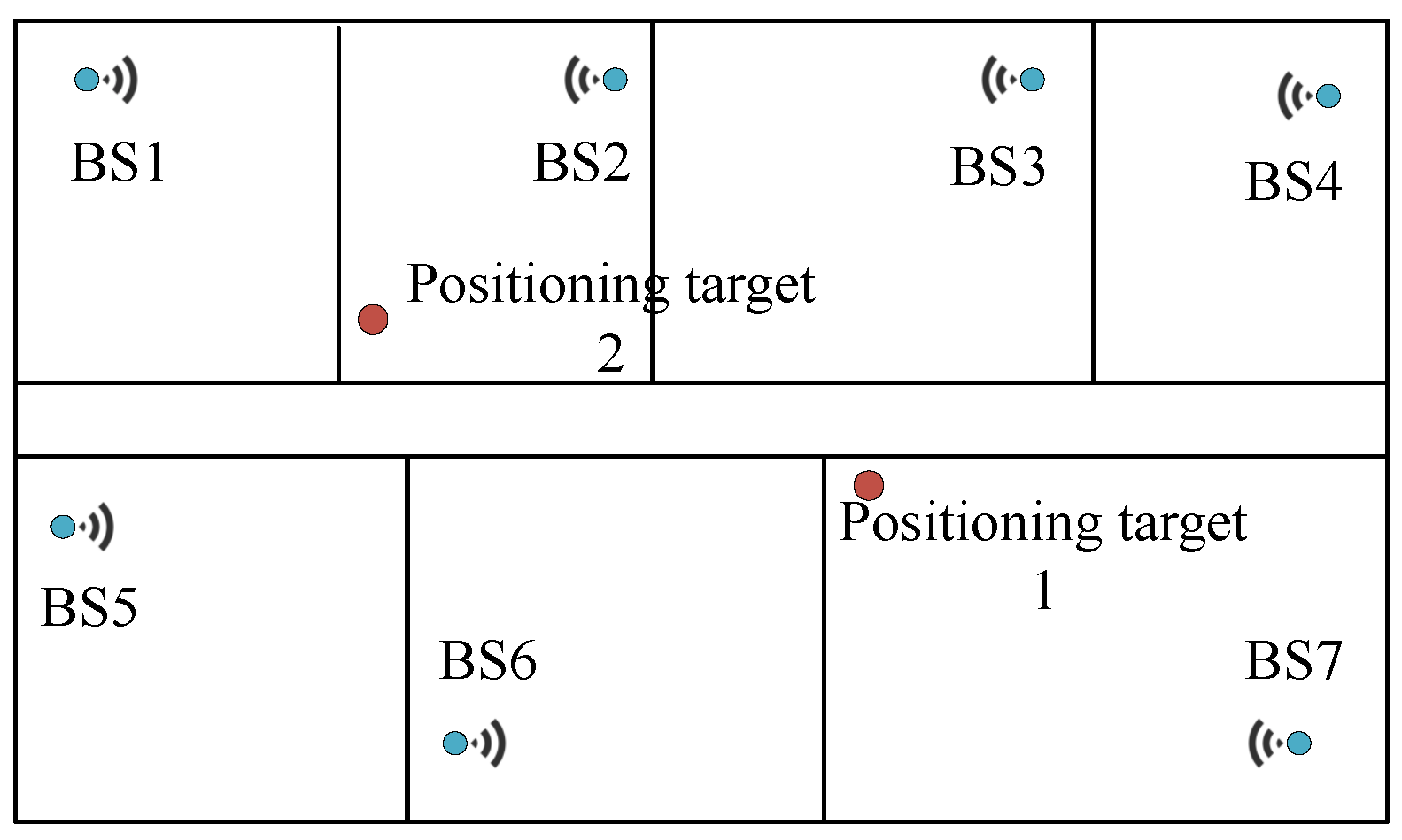
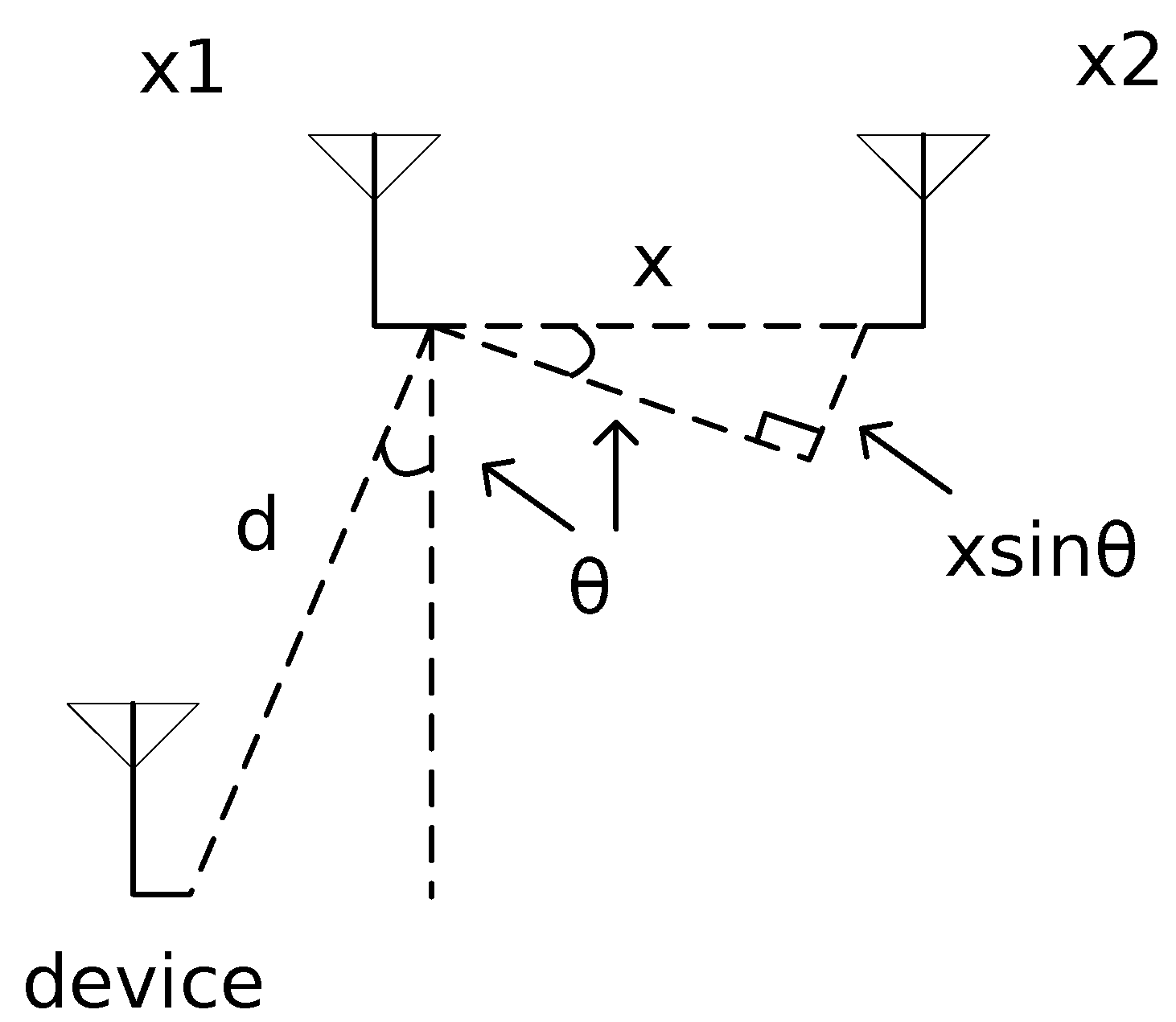
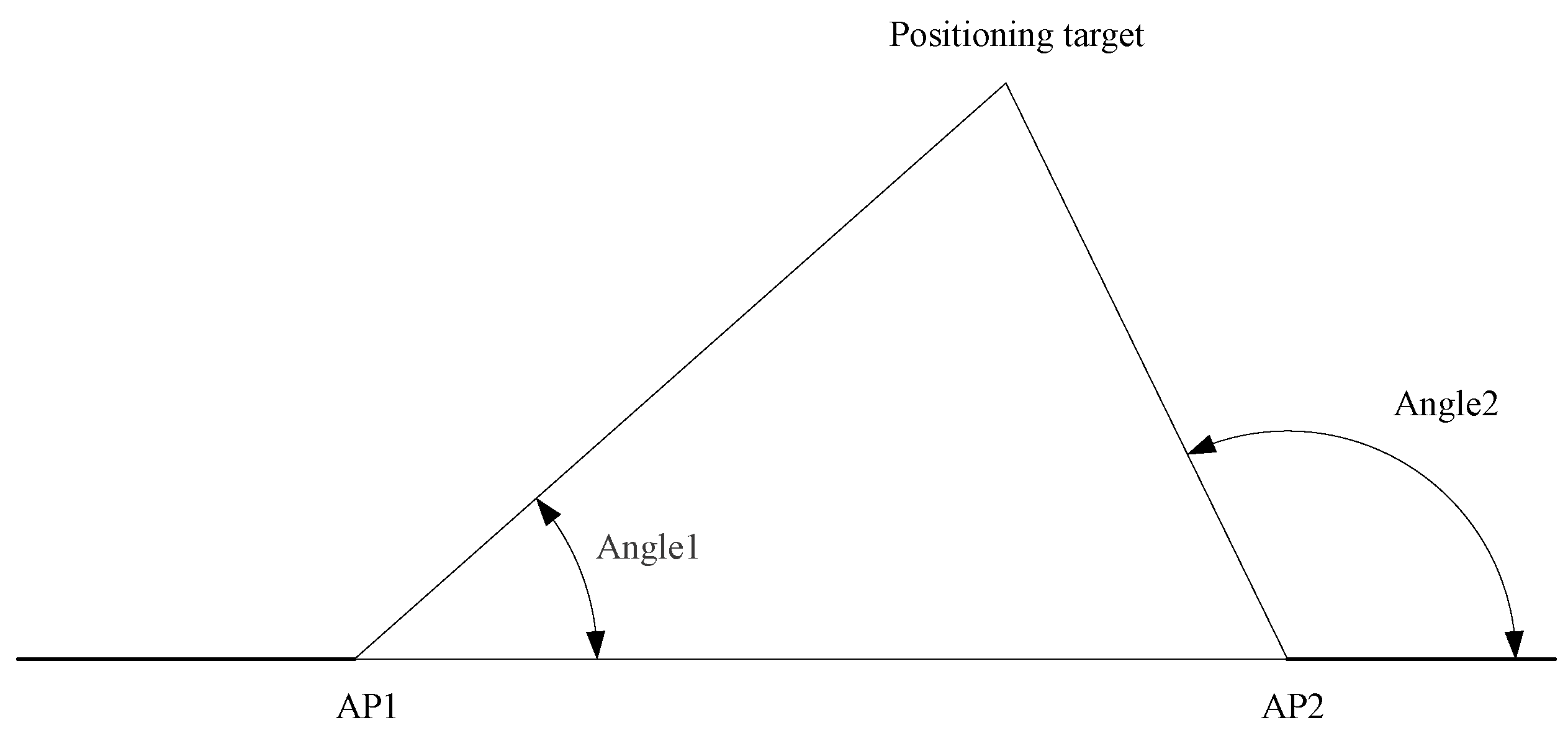
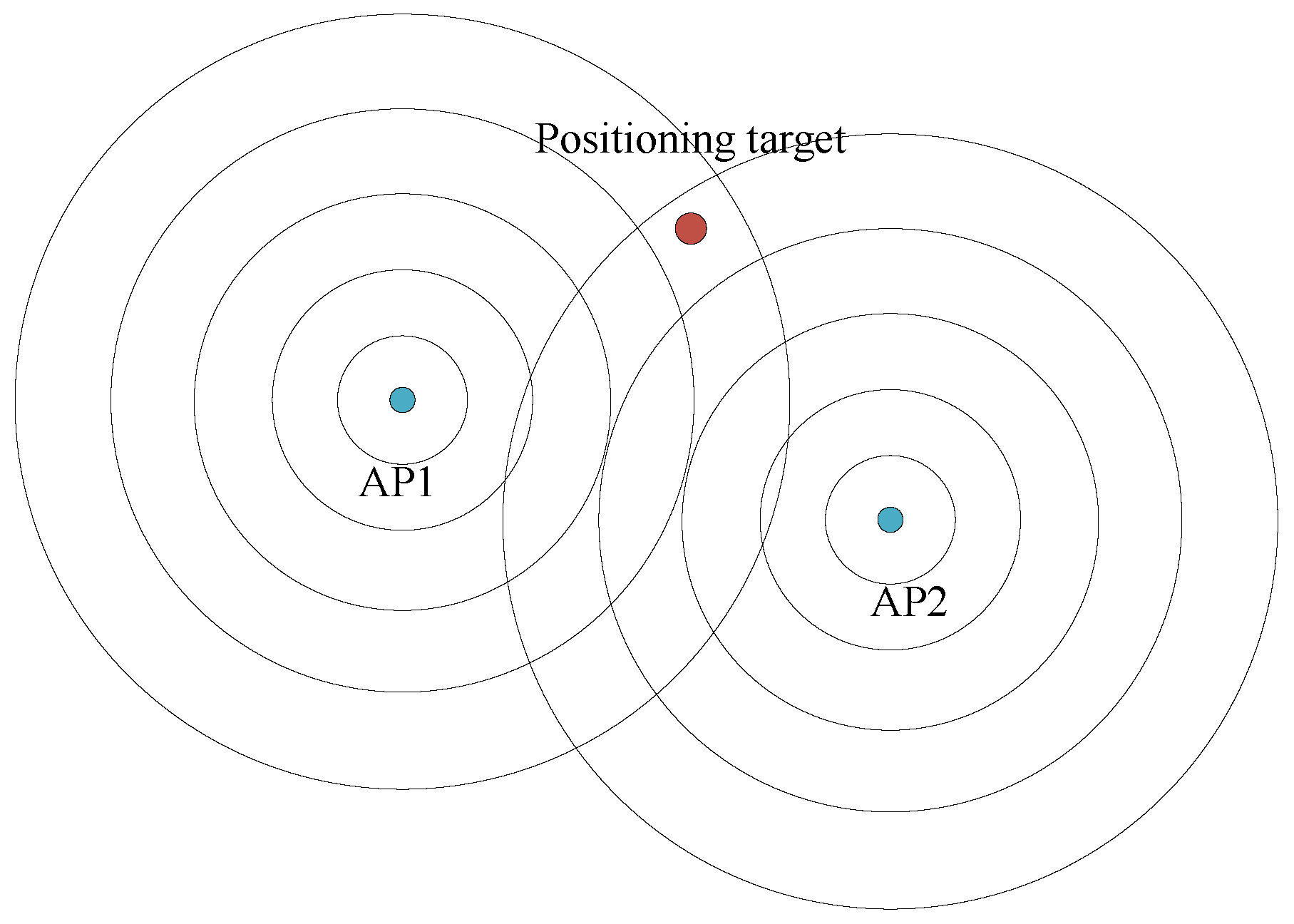
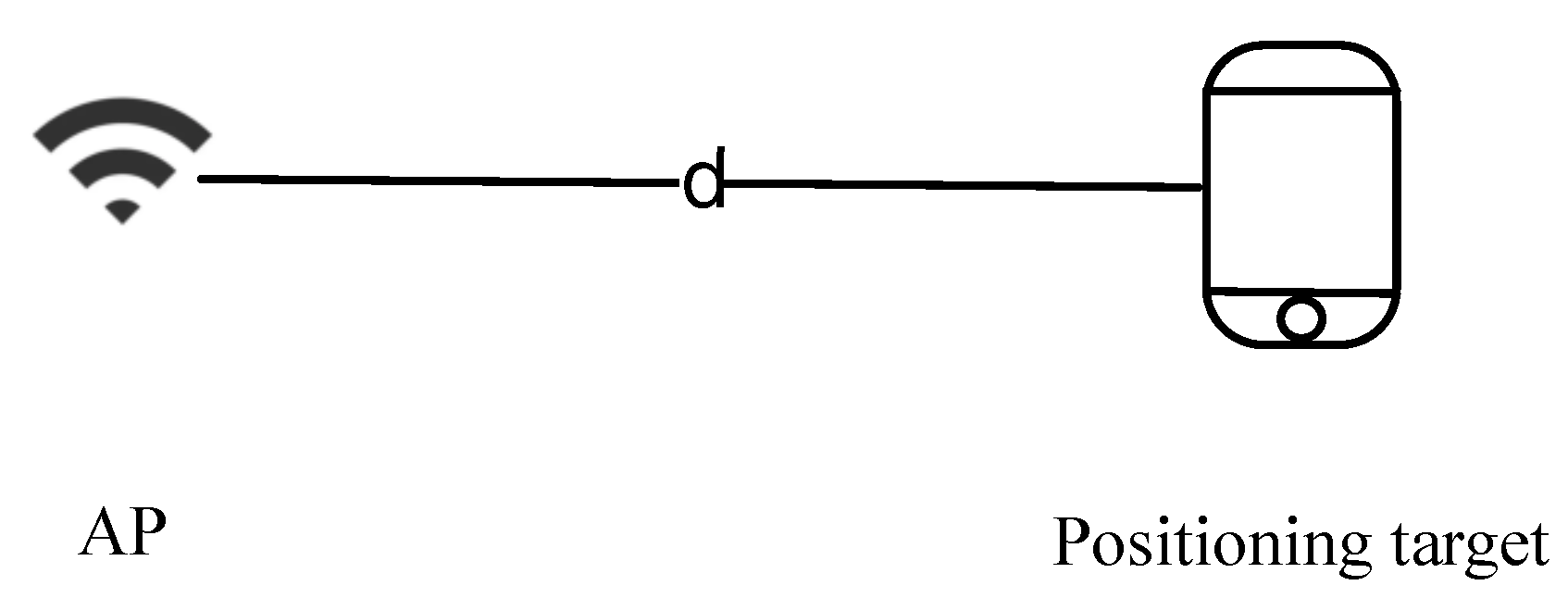
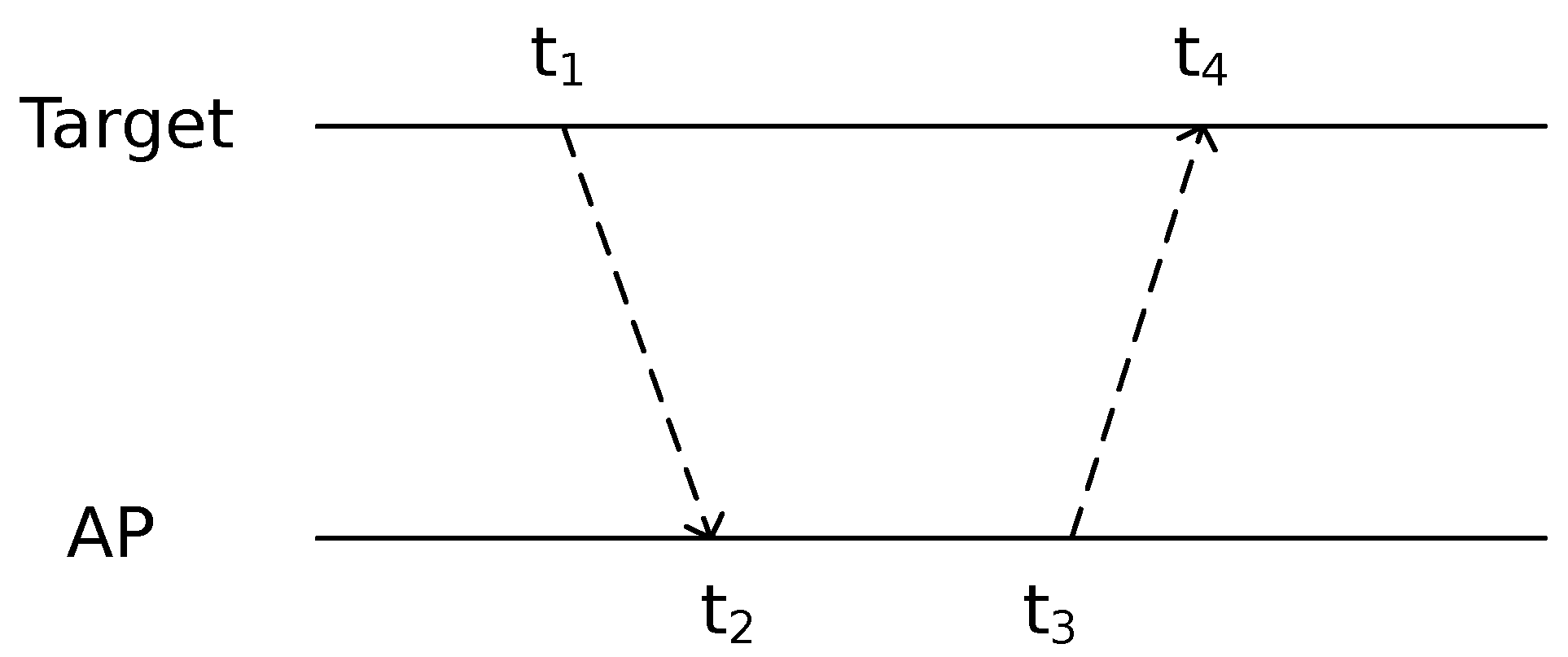
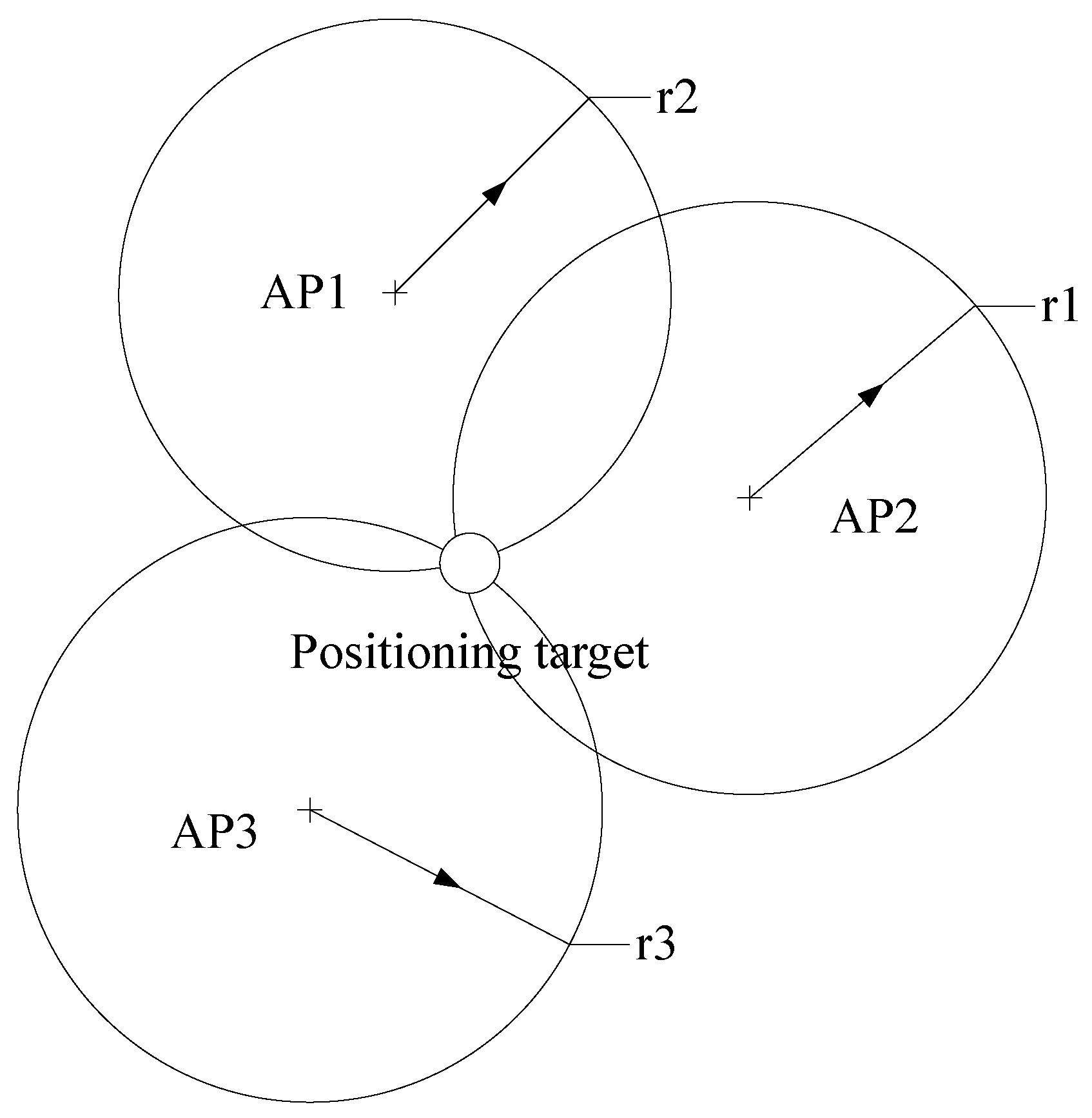
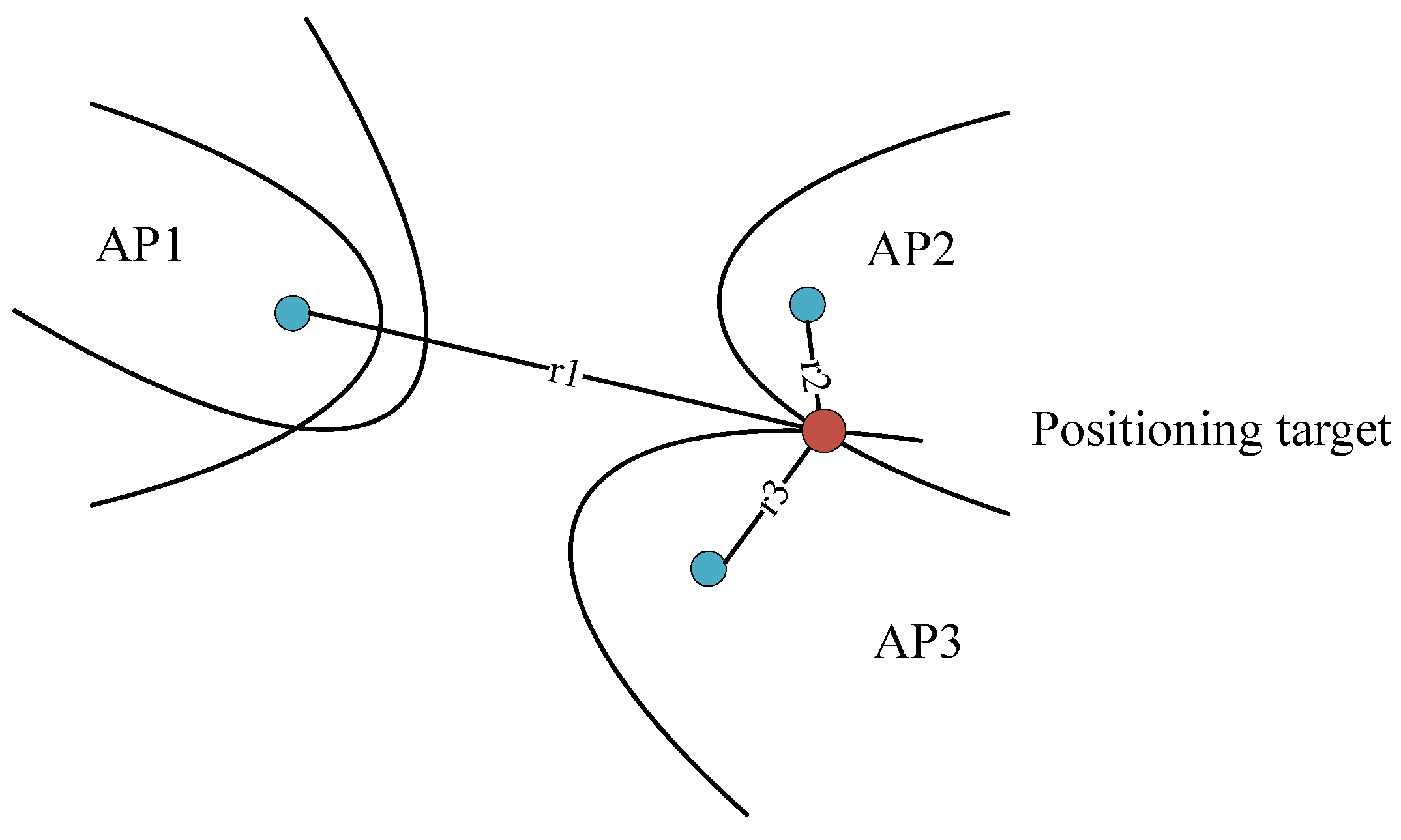
| Positioning Methods | Advantages | Disadvantages |
|---|---|---|
| ZigBee [14,15] | Low power consumption, low cost for a single node. | Short signal transmission distance, signal susceptible to interference. |
| Bluetooth [16] | Low power consumption, small device size, low cost for single Bluetooth beacon. | Poor signal stability, short effective distance. |
| UWB [17] | High accuracy, interference resistance, low power consumption. | High device cost. |
| RFID [18,19] | Low power consumption, small size, and low cost of electronic tag. | High system complexity, hard to integrate electronic tag with mobile devices, short effective distance. |
| Ultrasonic [20] | High accuracy. | Signal susceptible to interference, high device cost. |
| Infrared [21] | High accuracy. | Signal susceptible to interference, high device cost. |
| Wi-Fi [22] | Long effective distance, low device cost, easy deployment, low power consumption. | Signal susceptible to interference, low accuracy. |
| Positioning Schemes | Active/Passive | Device Requirements | Accuracy |
|---|---|---|---|
| CUPID [23] | Active | ≥1 AP | 5 m (1 AP) |
| AWL [24] | Active | 1 AP | 0.38 m (6 antennas) |
| TagFi [25] | Passive | ≥1 AP, 1 Wi-Fi receiver | 0.2 m |
| SAP-AoA [26] | Active | 1 AP | 0.85 m |
| Arraytrack [4] | Active | ≥3 APs with 6 or 8 antennas | 0.57 m (3 APs) |
| iLocScan [28] | Active | 7 universal software radio peripheral (USRP) 2 units with 8 antennas | 1.9 m (linear antenna array) |
| DeTrack [29] | Active | 3 APs | 0.9 m (80%) |
| Ubicarse [30] | Active | ≥3 APs | 0.39 m (3D device positioning) |
| TyrLoc [31] | Active | ≥2 PlutoSDR with 8 antennas | 0.63 m (Wi-Fi) |
| UAT [33] | Active | ≥3 APs | 1.3 m |
| MapFi [34] | Active | ≥3APs | — |
| WiCo [35] | Active | 3 APs | 0.73 m |
| Positioning Schemes | Active/Passive | Device Requirement | Accuracy |
|---|---|---|---|
| RADAR [11] | Active | 3 base stations | 1.3 m |
| Horus [39] | Active | Multiple APs | 0.6 m |
| Nuzzer [40] | Passive | 3 sending APs, 2 MPs | 1.82 m |
| FiDo [41] | Passive | 1 AP, 1 Wi-Fi receiver | Sub-meter level |
| Shi et al. [42] | Active | Multiple APs | 0.7 m |
| FPM [43] | Active | Multiple APs | — |
| LPPD [12] | — | — | — |
| Yang et al. [45] | Active | Multiple APs and UWB anchors | 1.8 m/0.9 m |
| Wu et al. [46] | Active | Multiple APs | 3.34 m/4.5 m |
| CWIWD-IPS [47] | Active | — | 4.06 m |
| Wang et al. [48] | Active | Multiple APs | 1.02 m |
| Regani et al. [49] | Passive | 1 AP, Multiple Wi-Fi receivers | — |
| DLoc [50] | Active | Multiple APs | 0.8 m/0.94 m |
| FedPos [51] | Active | 1 AP, 1PC, Multiple Raspberries | 0.42 m |
| LiPhi++ [54] | Active | Multiple APs | 0.67 m |
| Quezada-Gaibor et al. [56] | Active | Multiple APs | — |
| LiFS [36] | Active | Multiple APs | 5.8 m |
| Zee [8] | Active | Multiple APs | 3 m |
| MonoFi [57] | Active | 1 AP | 0.8 m |
| Caso et al. [58] | Active | Multiple APs | — |
| SMOTE [59] | Active | Multiple APs | — |
| Wei et al. [60] | Active | Multiple APs | — |
| Liu et al. [61] | Active | Multiple APs | 1.45 m/8.54 m |
| WF-ECS [62] | Active | Multiple APs | — |
| SAS [63] | Active | Multiple APs | — |
| ACOGAN [64] | Active | Multiple APs | 2.02 m (Field experiment) |
| TransLoc [65] | Active | Multiple APs | 1.1 m (Office building)/4.0 m (Shopping mall) |
| DAFI [66] | Passive | 1 AP, 1 Wi-Fi receiver | Sub-meter level |
| Song et al. [67] | Active | Multiple APs | 2.65 m (11th month) |
| Saccomanno et al. [68] | Active | Multiple APs | — |
| Zhou et al. [69] | Active | Multiple APs | 1.86 m |
| FCLoc [70] | Active | Multiple APs | <1 m |
| Yao et al. [71] | Active | Multiple APs | 2.8–3.29 m |
| Positioning Schemes | Active/Passive | Device Requirement | Accuracy |
|---|---|---|---|
| EZ [37] | Active | ≥4 APs | 2 m/7 m |
| Yang et al. [72] | Active | ≥3 APs | <0.05 m |
| Hyder et al. [73] | Active | 3 APs | <0.5 m |
| GTBPD-LSQP [74] | Active | Multiple APs | 2.099 m/2.112 m/2.635 m |
| Choi [75] | Active | Multiple APs | 1.038 m |
| Wang et al. [76] | Active | Multiple anchors | – |
| Positioning Schemes | Active/Passive | Device Requirement | Accuracy | Principle |
|---|---|---|---|---|
| ToneTrack [10] | Active | ≥3 APs | 0.9 m | TDoA |
| Chronos [78] | Active | 1 AP with 3 antennas | 0.65 m/0.98 m | ToF |
| TWINS [79] | Active | ≥3 APs | 1.8–3.8 m | ToA |
| UbiTrack [80] | Active | No AP | <2 m (RE = 0.5 m) | ToF |
| Suraweera et al. [81] | Active | Multiple sniffers | 0.5 m/0.2 m | TDoA |
| DBSCAN-assisted SPSO [82] | Active | Multiple APs | 1.147 m (2D)/0.305 m (altitude) | ToA/FTM |
| Chan et al. [83] | Active | Multiple APs | — | ToA/FTM |
| CbT & WCCG [9] | Active | ≥4 APs | 1.2 m (static)/1.3 m (dynamic) | ToA/FTM |
| AW-WFP [84] | Active | Multiple APs | 1.31 m/3.72 m | ToA/FTM |
| Wang et al. [85] | Active | ≥3 AP | 1.5 m | ToA/FTM |
| EMEA-WLS [86] | Active | Multiple APs | 1.82 m | ToA/FTM |
| Chan et al. [87] | Active | Multiple FTM receivers | 0.75 m/0.77 m/0.94 m | FTM |
| Positioning Schemes | Active/Passive | Device Requirement | Accuracy | Principle |
|---|---|---|---|---|
| xD-Track [88] | Passive | 1 AP with 1 sending antenna and 1 AP with 4 receiving antennas | — | ToF/AoA |
| mD-Track [89] | Passive | A pair of transmitter and receiver using wireless open access research platform (WARP) with 8 antennas or AP with 3 antennas | 0.36 m (WARP)/0.67 m (AP) | ToF/AoA |
| MaTrack [13] | Passive | 1 signal transmitter and 2 APs with 3 receiving antennas | 0.6 m | ToA/AoA |
| Yen et al. [90] | Passive | Wi-Fi transmitters and 3-antenna arrays | 0.089 m/0.354 m | RSSI/AoA |
| UbiLocate [91] | Active | ≥2 APs | 0.75 m/1 m | ToF/AoA |
| NLoc [92] | Active | ≥3 APs | — | ToF/AoA |
| Choi et al. [93] | Active | ≥3 APs | 2.397 m (RSSI)/1.547 m (FTM) | ToA/FTM/RSSI |
| Sail [94] | Active | 1 AP with 3 antennas | 2.3 m | ToF/RSSI |
| WiSight [95] | Active | Multiple localizing device with FSA | 0.95 m | ToF/AoA |
| MonoLoco [96] | Active | 1 AP | 0.5 m | ToF/AoA |
| SpotFi [97] | Active | ≥3 APs with 3 antennas | 0.4 m | ToF/AoA |
| [3] | Active | 1 AP with 3 antennas | 0.71 m | ToF/AoA |
| P2PLocate [98] | Active | Back-scatter tag, a single-antenna device (receiver) | 0.88 m | ToF/AoA |
| Jin et al. [99] | Active | 2 APs with two external antennas | <0.5 m | FTM/AoA |
| UKFWiTr [100] | Passive | 1 transmitter with 1 antenna and 1 receiver with 3 antennas | 0.49 m | ToF/AoA |
| AUKF [101] | Active | Multiple APs | Meter level | ToA/FTM/RSSI |
| Choi et al. [102] | Active | Multiple APs | 1.04 m | ToA/FTM/RSSI |
| H-WPS [103] | Active | ≥4 APs | Meter level | ToA/FTM/RSSI |
Disclaimer/Publisher’s Note: The statements, opinions and data contained in all publications are solely those of the individual author(s) and contributor(s) and not of MDPI and/or the editor(s). MDPI and/or the editor(s) disclaim responsibility for any injury to people or property resulting from any ideas, methods, instructions or products referred to in the content. |
© 2023 by the authors. Licensee MDPI, Basel, Switzerland. This article is an open access article distributed under the terms and conditions of the Creative Commons Attribution (CC BY) license (https://creativecommons.org/licenses/by/4.0/).
Share and Cite
Dai, J.; Wang, M.; Wu, B.; Shen, J.; Wang, X. A Survey of Latest Wi-Fi Assisted Indoor Positioning on Different Principles. Sensors 2023, 23, 7961. https://doi.org/10.3390/s23187961
Dai J, Wang M, Wu B, Shen J, Wang X. A Survey of Latest Wi-Fi Assisted Indoor Positioning on Different Principles. Sensors. 2023; 23(18):7961. https://doi.org/10.3390/s23187961
Chicago/Turabian StyleDai, Jihan, Maoyi Wang, Bochun Wu, Jiajie Shen, and Xin Wang. 2023. "A Survey of Latest Wi-Fi Assisted Indoor Positioning on Different Principles" Sensors 23, no. 18: 7961. https://doi.org/10.3390/s23187961
APA StyleDai, J., Wang, M., Wu, B., Shen, J., & Wang, X. (2023). A Survey of Latest Wi-Fi Assisted Indoor Positioning on Different Principles. Sensors, 23(18), 7961. https://doi.org/10.3390/s23187961







